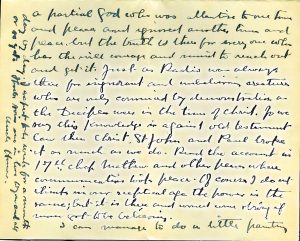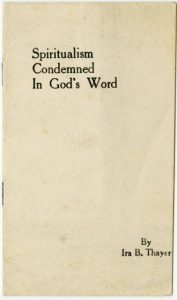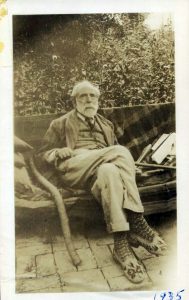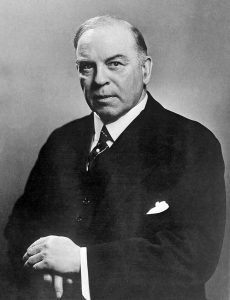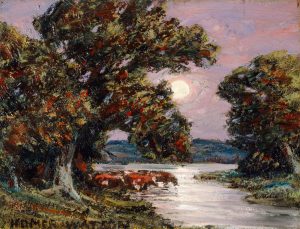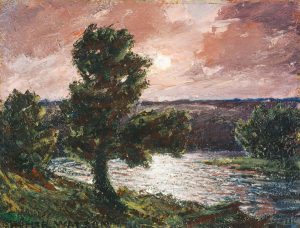Homer's Haunted History Tour
Welcome to Homer Watson House & Gallery. This tour will guide you through some of the rooms from Homer Watson’s home and studio through the lens of his spiritualist beliefs. Begin your tour by entering the Cayley gallery.
As you come in the front door of the gallery, turn left and enter the small contemporary gallery space, you should see a small room label on the wall outside of the room.
Cayley Gallery
Welcome to the Cayley gallery. This room was originally the parlour in the Watson home. A heavy door closed off the room from the rest of the house and there was no passage through to the ‘Best Bedroom’ or main bedroom, as there is today. Thick, wooden baseboards and molding lined the perimeter of the room, and in front of the velvet-dressed windows stood a piano. Like other parlours of the late Victorian period, it was probably decorated with patterned wallpaper, comfortable upholstered furniture, a small table or two, and an area rug. Knick knacks, plants and lace doilies likely dotted the surfaces, and until around 1915, it was lit solely by candles and oil lamps in the evenings.
Parlours like the Watson’s were used for entertaining, socializing and relaxing – the closest modern equivalent is the sitting room. Music-making and card games were standard pastimes of the day, but in the mid to late 19th century, a craze for the occult transformed parlours into spaces that hosted amateur magic shows, séances, and experiments with the supernatural.
The heightened interest in séances was due to a movement called spiritualism. It was based on the belief in a neutral afterlife where people’s souls passed after death, and that those in the spirit realm could be contacted by the living. The movement was popularized by famous mediums who travelled around North America to show off their abilities to believers and skeptics alike.
Spiritualism was not a centralized religion, meaning that an individual’s faith could vary greatly; however, the practices associated with spiritualism remained consistent. Séances of differing forms were carried out to convene with the dead.
Homer Watson hosted séances in his parlour to reach loved ones who had passed away. A group of Homer’s friends would have gathered around a dimly lit table, usually with a medium guiding them (although sometimes Homer conducted them by himself). Nighttime was preferred as it was believed that during this time, the veil between the living and spirit worlds was thinnest. If a medium was conducting the séance, they might have used trance writing, which involved recording messages on notecards from spirits. Other mediums conveyed messages from spirits to members of the party or were possessed by them for a short time. Another popular method was directing communication with ghosts by listening for raps from them to answer specific yes or no questions. In a note from around 1920, Homer describes a séance with taps at a friend’s cottage in Wellesley, Ontario:
“It was at a seance in Paradise Lake that maple trees came and taped [sic] me on the head and by raps told me when asked is there anyone from my diggins here from Doon taps, yes, who, Old Man Perine what is he doing there, picking up string – a pecularity [sic] he had of picking up bits and making them into a ball saving it although a manufacturer of it in quantity.”
Despite its popularity, spiritualism remained taboo in traditional Canadian society. Homer was private about his beliefs until much later in life, when he wrote a series of editorials on the subject to The Toronto Globe. Even the former prime minister of Canada, William Lyon Mackenzie King was heavily involved in spiritualism, but he did not want this information known to the public. Hailing from Kitchener himself, Mackenzie King was friends with Homer and the two participated in séances together (read more about their relationship below). Perhaps the general nonacceptance of spiritualism is a reason why the private parlour was favoured by those wishing to explore the paranormal.
Professor E. Ray Lankester Giving Evidence in the Trial of Dr. Slade, The American Spiritualist, For “Vagrancy,” in a Magistrate’s Court in London, 1876, The New York Public Library Digital Collections. Many world-renown mediums were charged for fraud or vagrancy in high profile cases, which did not help spiritualism’s public image in the 19th century.
Scientific advancements like Darwin’s theories on evolution were challenging traditional Christian faith and a host of new spiritualities gained popularity in the mid 1800s: many people were trying to reconcile their beliefs with scientific inquiry. As a result, many spiritualists thought that the presence of ghosts and mediums’ abilities could be proved (or disproved) using scientific methods. This gave rise to Societies of Psychic Research, including one based in Kitchener on 40 King Street East called The Ontario Society for Psychic Research. Homer Watson was close friends with the president of the society, David Forsyth. The group invited renowned mediums to conduct séances at the Watson house and elsewhere in Waterloo Region. One frequent locale for séances was at Forsyth’s cottage in Paradise Lake in Wellesley, which is mentioned in Homer’s note, above.
Walk into Ferrie gallery (the Best Bedroom), using the doorway that did not exist in Homer’s lifetime. Stop in front of the other doorway and look towards the staircase and Watson Studio.
Bottom of the Stairs
In 1918, Homer Watson’s wife, Roxanna, passed away from a heart condition called angina pectoris. They were companions for 37 years and had a loving, supportive relationship. Along with the deep sorrow Homer felt at the loss of his wife, he also felt her absence in his artistic process. Roxanna often gave her thoughts on Homer’s artwork, and he trusted her vision entirely. After her death, Homer experienced a creative block that lasted approximately a year, until he had a vision.
One evening, while he was sitting in the rocking chair in his studio, he noticed something at the bottom of the staircase. In a “curious amber glow” he saw Roxanna. Homer said that her ghost spoke to him and said, “Do not despair. All is well, Homer.”
Group photographs with Homer, Roxanna and friends (Homer and Roxanna are 2nd and 3rd from the left in the bottom photograph)
Seeing Roxanna that night provided Homer with some comfort and he regained confidence in his painting. Not only did this experience aid Homer in his grief, but it also intensified his interest in séances, spiritualism and connecting its tenets with the Bible.
After seeing Roxanna’s ghost, he considered Christianity more seriously than he had done before. But unlike many of his contemporaries, he did not consider spiritualism and the Bible to be in conflict. In a letter to a friend, Colonel Frank Moss, Homer said:
Since I lost my wife, I have found great comfort in the Bible. I had simply discarded the old Book, or become indifferent to it. The key to harmony in religion is a belief in a future life; and, in as far as we believe this, we are all spiritualists.
[In justifying séances:] What about the miracles of the disciples and the revelation of the resurrection itself?… They’ve impressed me a great deal, but I’m still keeping my mind open. However, there is spiritism in the Bible. It may be a belief in eternal life inspires it. Something in nature makes us aware of this.
From a young age, Homer had been put off formal organized religion because of his mother’s Christadelphian zeal. Homer and his siblings were not allowed to read fairy tales in the house and when his mother frequently hosted a Bible study, he escaped to visit his grandfather. Early in his life, Homer experienced the deaths of his father from typhoid and his brother from a workplace accident (which he witnessed) in quick succession. He did not seek comfort in his mother’s faith, but was drawn to alternative spiritualities. Although Homer said himself that his interest in spiritualism was not influenced by the deaths of his father and brother, it certainly would have changed the young Homer’s outlook. In 1880, Homer and three friends made a canoe trip down to Lily Dale, a spiritualist settlement in upstate New York.
Grand River Canoeing Club, c. 1879. Homer Watson is center back and David Forsyth (president of The Ontario Society for Psychic Research) is center front. This is the group of friends that made the trip down to Lily Dale together.
In the 1920s, Roxanna’s death deepened Homer’s interest in spiritualism and he went back to Lily Dale numerous times. Here he listened to lectures, witnessed demonstrations, and partook in séances with world-renowned mediums. He may have also had the photograph below taken of him while he was there. Spirit photographs were very popular in the late 19th century because it was believed that the camera lens could capture light that the human eye could not see, therefore unveiling ghosts. By the time Homer got this picture taken around 1930, it would have been widely known that spirit photographs were faked using multiple photographic negatives.
There are several examples of Homer connecting spiritualism and Christianity in letters written to his niece Myrtle Bean. Read these two letters to Myrtle to gain more insight into Homer’s personal beliefs.
Doon, April 25th, 1926
Just as Radio was always there for [ignorant] and unbelieving creatures who are [easily] convinced by demonstration as the Disciples were in the time of Christ. [If] we say this knowledge is against Old Testament law then Christ, St. John and Paul broke it as much as we do. Read the account in 17[th] chap Matthew and other places where communications took place. Of course I do not think in our sceptical age the power is the same; but it is there and would come [?] if man got to be believing.
For devout Christians, spiritualism conflicted with a passage in Leviticus that prohibits necromancy, which is communicating with the dead in order to predict the future. Anything associated with the occult was considered necromancy by strict Christians; however, it appears that Homer did not use séances for this purpose, he used them to connect with loved ones. Also, as Homer stated in this first letter, he believed that Christ, St. John and St. Paul would have used mystical means to perform miracles and communicate with spirits.
A publication from 1923 denouncing spiritualism by Ira B. Thayer, a member of the Evangelical Church. Courtesy of the Toronto Public Library.
In the second letter to Myrtle, Homer is skeptical about spirits having absolute knowledge, or more knowledge about the universe than mortals:
Fernie, B.C., September 26th, 1926
I do not know the work you have read by Hudson Tuttle, but I have read other work of the sort and my conclusion is some of them appear speculation on the part of intelligences from another plane of existence reasoning things out much as we do. Most of them do not know much more than we do. They have had the added experience of passing over and knowing life in another world that’s something; but it is not infallible. There will always be something beyond for us to learn; so that life will be always full of a [?] striving and achievement. It must be so else we would want to die. Well I won’t go into philosophic criticism just now. Will save that till I get home and tell you about this and Lily Dale.
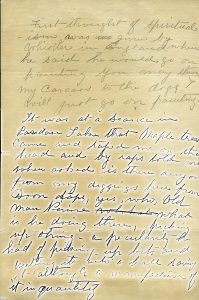
Continue past the stairs directly into Watson Studio. Take in his paintings in the first room and then proceed into the second, inner area stopping in front of the display of spirit cards.
Watson Studio
Homer Watson’s personal beliefs cannot be separated from his artistic practice – he had a sacred connection with his vocation. There are reports that Homer conducted séances in his studio space as well as in the parlour, perhaps to reach Roxanna or many of his artistic inspirations (look upwards to see the frieze of artists’ names who he admired). In describing his artistic process, Homer said, “It is the spirit that paints, if only I knew enough to let it take control. That’s when I make my best pictures, but the trouble is my carnal mind comes in and meddles too much. Then I make a mess of it, and that is what happens most of the time, I think.”
Spirit cards with messages from Roxanna to Homer. He made frequent attempts to contact Roxanna after her death.
Homer’s niece, Jane, remembers his devotion to landscape art a little differently: “He was a preacher, he said, in his own way. I thought he was joking, for he never went to church, but then I looked around me, and knew…Nature was his church and easel was his pulpit…he spoke of his paint, coloured mud, taking on the radiance of the celestial sphere.”
Homer undoubtedly had a preference for painting landscapes. For him, nature was the grounding framework for all of his spiritual beliefs. He thought that nature had the ability to guide humanity towards “Truth and Beauty.” Not only did his beliefs factor into his painting, he also protected Cressman’s Woods in Doon from land developers – it is now known as Homer Watson Park.
Homer wanted the stylistic qualities of his work to exemplify his beliefs, and this took on different forms throughout his life. When he first began painting, he created expansive landscapes that captured every detail, similar to Barnyard at Eventide created around 1886 (located on the wall parallel to the doorway). This approach attempted to overwhelm the viewer with wonder at the immensity and beauty of nature, communicated in realistic precision.
In comparison, The First Snow is an example of Homer’s later style where he was less concerned with detail, and more interested in the general atmosphere of a scene. Homer applied paint more thickly and used looser brushwork to create dynamic movement and highlight atmospheric effects, like wind or mist. Also, his later works depicted smaller scenes instead of sprawling landscapes in order to connect the viewer to nature in a more intimate way. Regardless of his earlier or later styles, both centered the environment and man’s place in it.
Spiritualism directly influenced the themes of Homer’s later works. The painting, Untitled (River by Moonlight), is a nocturne illuminated by the moon. As previously mentioned, spiritualists believed that nighttime presented optimal conditions for communicating with ghosts. Homer explored this theme frequently in his later works, including two moonlit paintings of the Grand River commissioned by William Lyon Mackenzie King.
“I have a high regard for Mr. Mackenzie King. He has a fine mind and a deep and appreciative understanding of art.”– Homer Watson
Homer Watson and William Lyon Mackenzie King met for the first time when King was a boy and went with his father to see Homer’s art in Doon. Nearly fifty years later in 1933, King re-visited the artist’s home and the two met again. They conversed about familiarities, art and then bonded over spiritualism by chance. Spiritualism became the lifeblood of their subsequent friendship. Homer and King were both connected with the Ontario Society of Psychic Research and participated in séances together – notably one took place on a Friday the 13th in Homer’s parlour.
During that visit in 1933, Mackenzie King became struck by Evening Moonrise (below) while perusing Homer’s gallery. He wanted to purchase the painting, but Homer insisted on perfecting the piece before it went into King’s hands. While waiting for the finished painting, King wrote in his diary that he received an anxious letter from Homer: “the real artist, humble as ever of his [talents]…unable to realise the goal he has set for himself – to reveal God as he sees Him in Nature – the Moonlight sketch…is wanting a final touch… [I told] him not to hurry.” One painting ended up being two, as Homer felt that the initial painting would not do and sent the pair to Ottawa for Mackenzie King to choose.
Homer passed away in 1936, leaving an unfinished painting on his easel. His sister Phoebe had been “Dabbing a little wistfully at some of Homer’s unfinished work, [and] was reported to have attended a local spiritualist session at which she received a message from Homer. When asked what the message was, Phoebe laughed and said, ‘Homer says, leave my paintings alone.’”
Homer’s interest in spiritualism began at a young age and later impacted both his life and his artwork, demonstrated by the paintings in this room. Whether or not the seances were successful, it is clear that they were to Watson and without his most profound spiritualist experience, a visit from his deceased wife, Watson may have never entered the most prolific painting period of his life. In this period, Watson created some of his most ambitious and dynamic works.
This brings us to the conclusion of our spiritualist tour of Homer Watson House & Gallery. If you’d like to learn more about the property or the local area, check out some of our other walking tours here.

